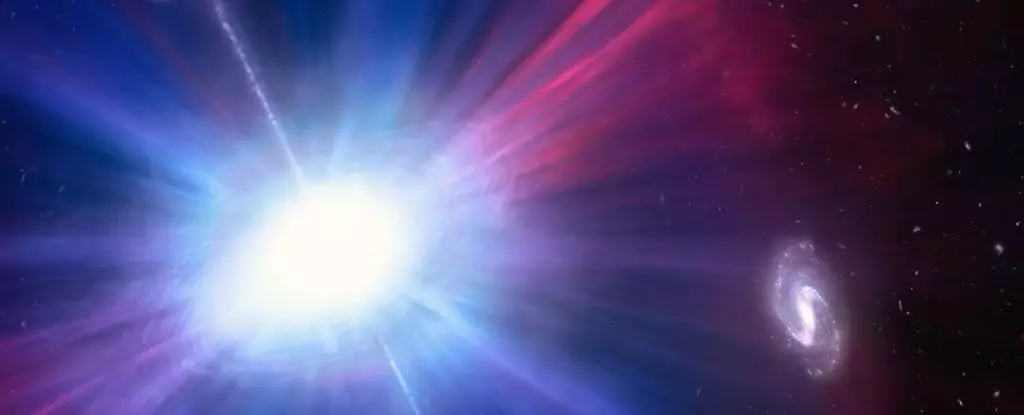We may know a heck of a lot less about a bizarre kind of cosmic explosion than we thought. They’re known as luminous fast blue optical transients, or LFBOTs, and one nicknamed the Finch (AT2023fhn) has been spotted in intergalactic space, at a significant distance from the nearest galaxy. This is a problem, because astronomers thought that LFBOTs could be a type of massive supernova – something thought only really to occur within galactic borders.
“The more we learn about LFBOTs, the more they surprise us,” says astronomer Ashley Chrimes of the European Space Agency and Radboud University in the Netherlands. “We’ve now shown that LFBOTs can occur a long way from their nearest galaxy, and the location of the Finch is not what we expect for a supernova.” The first LFBOT was spotted in 2018, and since then we have detected around a handful. With each new discovery, LFBOTs have continued to puzzle scientists.
These space explosions are tremendously bright – at least 10 times brighter than a normal supernova – and tremendously brief. Normal supernovas tend to flare to a peak, then fade over weeks or months; LFBOTs are like a camera flash in space. And they’re tremendously hot; that’s what gives them a bluish hue.
Scientists thought that these events might be caused by an unusual type of core collapse supernova, in which a dying star’s core directly collapses into a neutron star or black hole. This requires a massive progenitor star, at least eight times the mass of the Sun. Another possibility is that the flashes could be caused by a black hole devouring another ultradense object, such as a white dwarf star.
Massive stars don’t live very long main sequence lives. It’s less than 100 million years for a star eight times the mass of the Sun. And they’re born in regions that are very rich with thick gas and dust, which means galaxies. There’s not a lot of matter in intergalactic space. Although some stars can get kicked out of orbit onto an escape trajectory and velocity out of their host galaxies, massive neutron star and black hole progenitors are not expected to get that far before their eventual supernovae. In fact, all previous LFBOTs have been discovered in the spiral arms of galaxies in which star formation is occurring – the expected place to spot a supernova.
This brings us to the problem of the Finch. It was detected by the Zwicky Transient Facility on 10 April 2023. Its temperature was measured at a whopping 20,000 degrees Celsius (around 36,000 Fahrenheit). Hubble was then called in to figure out where it came from. And this is where things started to get a little hinky.
The explosion took place some 2.86 billion light-years away – but in intergalactic space, some 50,000 light-years from the nearest spiral galaxy, and 15,000 light-years from the nearest dwarf satellite galaxy of that spiral galaxy. This poses a significant challenge to the supernova hypothesis. But the black hole hypothesis is still on the table.
It’s possible, the researchers say, that an old, isolated ball of stars known as a globular cluster is lurking in intergalactic space. Globular clusters are thought to be riddled with black holes, of the rarely-seen intermediate mass variety. If there’s a globular cluster there, too dim to be seen, it’s possible that we caught one of these black holes snacking indiscreetly.
Another possibility is that the explosion was caused by a collision between two neutron stars, one of which could have been a magnetar, whose extreme magnetic field could have amplified the resulting kilonova. Theoretical analysis will need to be done to determine the plausibility of this scenario.
“The discovery poses many more questions than it answers,” Chrimes says. “More work is needed to figure out which of the many possible explanations is the right one.”
The Unveiling of Cosmic Anomalies
One thing is certain, though. The more of these things we find, the weirder they get. As our understanding of LFBOTs deepens, the theories surrounding these cosmic phenomena become more complex and enigmatic. The Finch serves as a reminder that the universe is full of surprises, and that even the most knowledgeable astronomers cannot anticipate every twist and turn.
The discovery of LFBOTs in intergalactic space challenges long-held assumptions about the occurrence and nature of supernovas. It pushes us to reconsider the possibilities and mechanisms behind these luminous explosions. As we continue to gather data and analyze the properties of LFBOTs, we inch closer to unravelling their true origins and unraveling the mysteries of the universe.
In the quest for answers, scientists will explore simulation models, conduct meticulous observations, and engage in rigorous theoretical analyses. The implications of understanding LFBOTs extend beyond the realm of astrophysics, touching on the fundamental nature of stellar lifecycles, black holes, and the existence of yet undiscovered structures in the vastness of space.
While the Finch may have presented us with a cosmic riddle, it also represents an opportunity—a chance to expand our knowledge, challenge existing theories, and embrace the beauty of the unknown. And so, we embark on a scientific odyssey to decipher the secrets of LFBOTs, one puzzling discovery at a time.


Leave a Reply